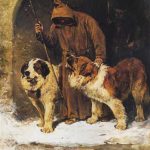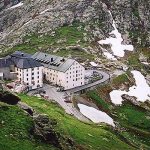The Great Saint Bernard Hospice, Switzerland
About Saint Bernard Pass:
Located less than a mile for the border with Italy, the Saint Bernard Pass became famous over the centuries as the main route for armies and pilgrims alike. For pilgrims, it was the pathway south to Rome or the Holy Land, or for those going north from Italy to Santiago de Compostela.
About Saint Bernard of Montjoux:
Born around 923 AD (we don’t have an exact date), Bernard has erroneusly been called Saint Bernard of Menthon, which is incorrect. Bernard of Montjoux came here from Italy and over time became concerned as he met people who had been robbed by bandits while making this crossing. Also, it was treacherous in the winter and many people became lost and died trying to cross.
To help alleviate these risks, in 962 he founded a hospice at the top of the mountains to serve as a refuge and meeting place. It grew in popularity and stature, garnering the attention and admiration of many Christians who began to bestow gifts on the hospice. The hospice continued to grow and expand over the years, and still exist today, although the crossing can now be completed by tunnel..
Saint Bernard of Montjoux died in June 1008. He was canonized in 1681 by Pope Innocent XI. His Feast Day is celebrated May 28. He is patron saint of skiers and mountain climbers.

Of course, no mention of the hospice is complete without discussing the famous Saint Bernard breed of dogs. Since the hospice is located high in the Alps (8,000 feet or 2,400 meters) above sea level, the weather is cold most of the year and winters can be severe. Travelers risked more than robbers on their journey: they would sometimes get lost in the snow. The breed we know as the Saint Bernard (developed here at the Abbey) has an excellent sense of smell and direction and is able to handle cold temperatures. It has been reported that during a period of about 200 years, about 2,000 people were rescued by these dogs, the last documented recovery being in 1897 when a 12-year-old boy who had fallen in a crevice and fallen asleep was awakened by the barking of one of the dogs.
About the Great Saint Bernard Hospice:

Individuals and groups are welcome to spend time here. They have accommodations in either dormitory or private rooms. The daily schedule includes vespers, Sunday Mass and more.
You need to be aware that this is a monastery and not a hotel. Meals are served at specific times. Needless to say it is best to reserve in advance, especially for groups.
There is also a museum open during the summer months. Admission is charged for the museum.
Traveling to the Great Saint Bernard Hospice in Bourg-St.-Pierre, Switzerland:
From June 1 through October 15th you can drive to the monastery; however, be aware that it can snow in any month. There is no direct train service, but you can start at Martigny then take the “Saint Bernard Express” to Orsieres and from there you can take a bus to the monastery. If weather permits, we definitely recommend the drive for its splendid scenery.
In the winter it is quite difficult to reach, you will need to use skis or snowshoes for the two-hour trek. If you plan to visit here during the winter we suggest you contact them in advance.
Address: 1946 Bourg-Saint-Pierre, Switzerland
GPS coordinates: 45° 52′ 8.6448” N, 7° 10′ 14.8980” E
Tel: +41 27 787 12 36 Fax: +41 27 787 11 07
e-mail: hospice@gsbernard.net
Click here for the official website of the Hospice du Grand Saint Bernard (in French)
Sources:
1. Great Saint Bernard Monastery
2. Smithsonian Institution.

